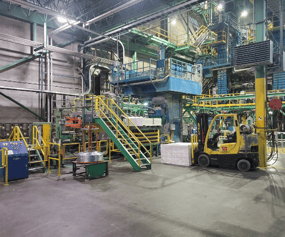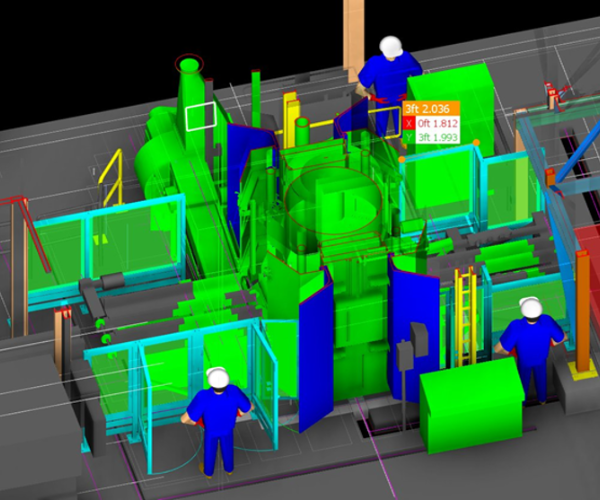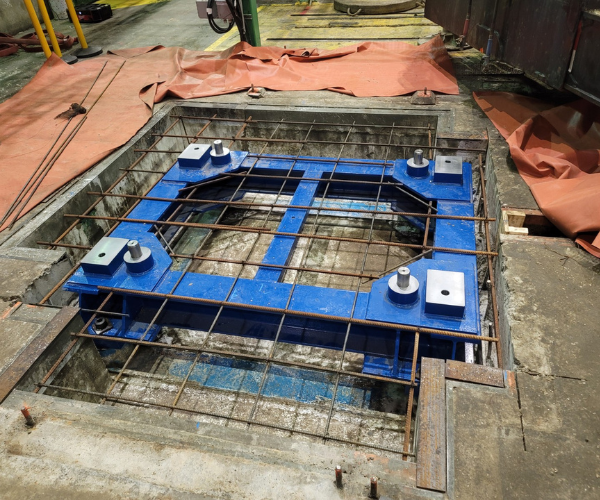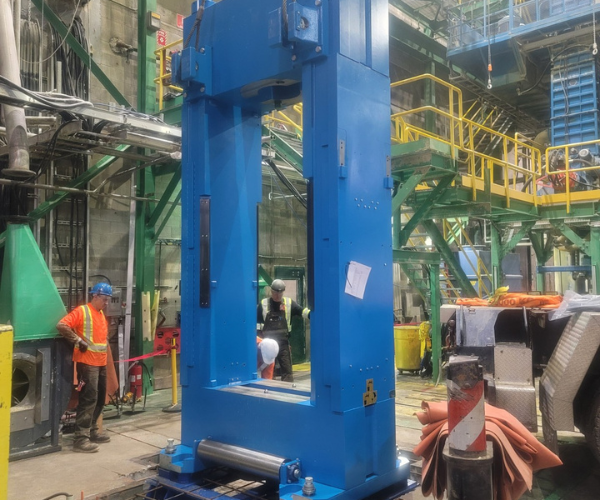Slave Lake Pulp operates a 290,000 metric tonnes per year bleached chemical thermo-mechanical pulp (BCTMP) mill in northern Alberta. The mill feeds primarily aspen through Sunds CD refiners and subsequent bleaching stages to produce market pulp for the global BCTMP market. The mill operates a single baling line, which contains a PAM-1500 bale press nearing the end of its life thus requiring replacement with a new Valmet (PR-15) Bale Press.
Slave Lake Pulp, a subsidiary of West Fraser Timber Co. Ltd., engaged Allnorth Consultants Limited (Allnorth) to provide project management, detailed engineering, and construction management services for the Bale Press Replacement Project. The scope of work included civil, structural, mechanical, piping, electrical, instrumentation, controls, and hazard and operability studies (HAZOP).
At Allnorth, we are proud to share our insight into the primary technology gaps, the importance of gap analysis, and the challenges encountered when upgrading technologies to new local jurisdictional codes and requirements, as testament to our successful execution of this important project.
Upgrading an old bale press line with new technology and a programmable logic controller (PLC) while bringing older process lines and mechanical piping up to code poses several technical challenges. In addition to the compatibility issues, software integration, and hardware upgrades, there is also the difficulty of upgrading to new local jurisdictional codes and requirements. These requirements may involve changes to welding procedures, piping types, and ABSA[1] requirements, making it essential to conduct a comprehensive gap analysis before embarking on the project.
Gap Analysis
Industry statistics reveal that over 50% of technology upgrade projects fail due to incomplete gap analysis. These failures can result in project delays, budget overruns, and equipment failure, which can be costly and detrimental to the overall success of the project. Our team at Allnorth understands the importance of evaluating civil, mechanical, PLC, and electrical requirements to ensure seamless integration and optimal performance of the new equipment. Through meticulous analysis and planning, we were able to minimize risks, prevent project delays, and meet our client's goals and objectives. Statistics show that incomplete gap analysis can lead to project failures, resulting in costly consequences. Therefore, we emphasize the significance of conducting a thorough gap analysis as an essential part of any technology upgrade project, to ensure success and maximize the return on investment for our clients.
Gap analysis is an important process that helps pinpoint the differences between the old and new technology used in the bale press line. It also helps identify any issues that may arise when updating older process lines and mechanical piping to meet current standards and regulations.
Allnorth conducted a thorough civil gap analysis which involved understanding the load requirements of the old equipment and comparing them with the new equipment. It was crucial to ensure that the new equipment would utilize a similar footprint and accommodate the weights and stresses of hydraulic equipment. Our team analyzed the load capacities, dimensions, and structural requirements of the old and new equipment to ensure a seamless integration without any compromise on safety or performance.
Another critical aspect of the gap analysis was the mechanical portion, which focused on matching conveyor lengths, heights, and piping. Allnorth diligently assessed the conveyor systems of the old and new equipment to ensure compatibility. This involved meticulous measurements, assessments of heights, and evaluations of piping and chutes to ensure that the new equipment would integrate seamlessly with the existing infrastructure. We also conducted a thorough analysis of pressure requirements to ensure that the piping met the required codes and standards for safe and efficient operation.
Allnorth carefully analyzed the existing PLC versions and control cabinets to determine the upgrades required for the new equipment. This involved upgrading the PLC versions to ensure compatibility and integration with the new system. Additionally, we designed and installed new control cabinets to accommodate the new equipment, including Safety PLCs that were not integrated into the bale line previously. Our team also conducted a comprehensive analysis of electrical requirements, including MCC Starter buckets, control cabling, and MCC Arc Flash study. This ensured that the new system had the necessary electrical infrastructure, including updated wiring and cable tray, to meet safety standards and performance requirements.
Allnorth utilized 3D scanning technology to ensure a smooth engineering path and successful installation. By leveraging this technology, our team was able to accurately measure, and take-off all required construction elements. This enabled them to identify appropriate construction methods and materials, ensuring that the project met all technical requirements and was completed with the highest level of accuracy.
In addition to utilizing 3D scanning technology, the gap analysis helped Allnorth identify areas that required upgrades, modifications, and new installations, creating an effective plan for the project.
Overall, the combination of 3D scanning technology and gap analysis enabled Allnorth to identify any potential compatibility issues and ensure that the project met all technical requirements. This approach ensured a fluid engineering path that led directly to installation success, with accurate measurements and take-offs.
Challenges
Upgrading process lines and mechanical piping in accordance with new local jurisdictional codes and requirements can pose several challenges. One of them is to implement changes to welding procedures. New codes may require different types of welds, and existing welds may need to be modified or redone, which can lead to additional costs and delays.
Alberta’s new local jurisdictional codes may also require the use of different piping materials, which may not be compatible with the existing piping. This may require the replacement of large sections of piping resulting in additional costs.
Finally, it is possible that ANSI[2] requirements for valves, fittings, and other components have changed since the original installation of the bale press line. As a result, it may be necessary to replace or modify some of the components to comply with the current requirements.
Critical Steps
To ensure the successful commissioning of the project while bringing older process lines and mechanical piping up to code, the Allnorth Team:
- Developed a comprehensive project plan that included timelines, milestones, and deliverables.
- Conducted a gap analysis to identify the differences between the old and new technology used in the bale press line, as well as any issues that may arise when updating older process lines and mechanical piping to meet current standards and regulations.
- Defined the project scope, including hardware and software requirements, and the necessary modifications to the existing line.
- Selected a reliable and experienced vendor to supply the new Valmet Bale Press and associated equipment.
- Created a detailed engineering design that includes hardware and software modifications, wiring diagrams, and installation plans, complete with modifications to process lines and mechanical piping.
- Tested and validated the new equipment, software, and piping modifications in a controlled environment before installation.
- Coordinated with the local jurisdiction to ensure compliance with all applicable codes and requirements.
- Trained the operators and maintenance personnel on the new equipment, software, and piping modifications.
- Conducted a final commissioning test to ensure the system was operating correctly and in compliance with all applicable codes and requirements.
Successful Outcomes
The West Fraser Bale Press Replacement Project was critical to the continued operation of the Slave Lake Pulp Mill, and it benefitted from Allnorth’s expertise in providing project management, detailed engineering, and construction management services.
Allnorth provided the right support to execute the project, focused on thorough gap analysis, engineering, construction management, electrical management, and commissioning. A definitive measure of our team’s success was that the West Fraser Bale Press Replacement Project was completed on time and on budget.
The bale press line was upgraded with new technology and brought up to code, improving the efficiency and productivity of the overall system. This was done through careful planning, engineering, and project management. The success of this project highlights the importance of gap analysis and the benefit of working with a reliable and experienced engineering firm to drive the successful completion of a project of this complexity.
[1] ABSA: the pressure equipment safety authority (of Alberta)
[2] American National Standards Institute
| Before |
3D Scan |
Bale Press Removed |

|

|

|
| New Bale Press Sub Frame |
New Bale Press Frame |
After |

|

|

|

